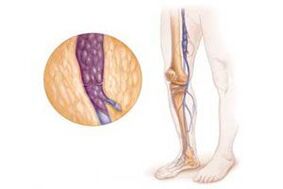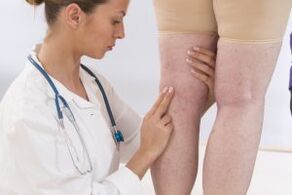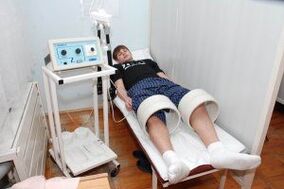
You do not need to remind the spread of vascular diseases.During the summer season, every time you go out, you can notice a blue network of calves of women and men.Not everyone knows for sure how dangerous this pathology is.
What are the varicose veins
What are varicose veins?It is a disease in which the peripheral arteries become swollen.They become excruciating, revived and protruding above the surface of the skin.
Normal circulation is impaired and pressure occurs.
When it reaches maximum concentration, the walls of the blood vessels extend.
The legs turn blue due to the large number of protruding vessels and a venous net.
Risk factors
The factors that cause the appearance of varicose veins include:
- taking hormonal medicines, pregnancy;
- the influence of extra pounds, obesity;
- hereditary factor;
- Work at high temperatures, constantly sitting or standing.
You need to constantly monitor your lifestyle.Avoid overworking your feet or do too much physical activity.
Prevention as soon as the first characters appear.

Reasons
There are two conditional subgroups: primary and secondary causes of illness.
Primary:
- Hard physical work;
- A sedentary lifestyle;
- weight gain;
- hereditary factor;
- Genetic location.
Secondary:
- stress and anxiety;
- pressure in the area of arterial blood flow;
- physical training with heavy weights;
- Too tight clothes, tight shoes;
- interruption of the endocrine system.
The mechanism of development of varicose veins
It all starts with mild symptoms, it seems that prostate fatigue affects the joints.At the end of the working day, swelling and pain appear in the calves and periodically bother me.
Soon, manifestations, noticeable to the naked eye, begin to develop.First, a light vascular network and then nodularity appears on the feet.
The mechanism of development of the disease should be stopped as soon as the first pain is felt.
Stages
There are 6 stages of varicose veins.They develop rapidly.If you do not treat the disease in the first stage, you can quickly find yourself on the operating table.
Degree - 0. One begins to feel the full range of sensations inherent in the disease, but the study does not show a positive result.
Degree - 1. Symptoms of progress and venous network appears on the legs.
Grade - 2. From this stage the manifestation of typical varicose veins begins.Joints pain after loading or long periods of stagnation.The arteries swell and nodes appear.
The degree - 3. The rest is added edema, which is more expressed in the evening.
Degree - 4. Trophic changes develop.The limbs become inflamed, the skin color changes and wounds appear.
Degree - 5. The same of all manifestations and cured ulcer.
Grade - 6. The trophic ulcer continues to develop actively.

Vascular malaise
This classification of varicose veins is divided based on the species of the affected body.
There are only 4 types of them, namely:
- Reticular varicose veins.There are no complications at this stage, only small capillaries touch.Therapy quickly eliminates this defect;
- segmental.It is considered the initial stage of varicose veins.The flowing arteries are tuned;
- The trunk is called varicose veins when a large and small subcutaneous artery is involved.The channels increase as the symptom is insufficient circulation;
- Punch.The binding veins and surface vessels under the skin expand.
The listed types of varicose veins are characteristic of different stages of development and manifestation of venous deformation.
Than the disease is dangerous in the absence of timely therapy
With this pathology, it is very important to consult a specialist in a timely manner.Each stage quickly goes into a new one.
As varicose veins are acquired, they can develop in more serious problems.
- Thrombosis.When the blood thickens, it clogs the blood vessels.Blood clots are formed.The legs hurt and swell.
- Telangiectasia.A disease that does not aesthetically decorate the legs.Vascular networks appear.Spasms and swelling are also disturbing.
- Thrombophlebitis.Complex disease with characteristic symptoms.Dark skin, redness, blockage of blood vessels, blood clots.
- Trophic ulcer.This is a consequence of severe varicose veins.The blood circulation is impaired, open wounds and ulcers appear.
- Bleeding.The arteries cover and swell the skin so much that it eventually thinners and tears.Hemorrhage can be internal or external.
Diagnostics
Often the symptoms are clear and clear.
You should not diagnose yourself;It is better to take a specialist exam.
Patient complaints
Initially, varicose veins did not manifest themselves in any way.
The most common complaints can be swelling, fatigue after walking in heels and cramps at night.

Clinical examination
The appearance of the lower limbs will indicate the diagnosis.The legs are swollen, with a mild or pronounced vascular network.
In the last stages, ulcers are possible.
Instrumental techniques
The doctor should be directed to ultrasound diagnostics.This method is very informative.It will show the condition of blood vessels, blood flow, patency, blood clots, etc.
Laboratory techniques
Using tests, you can't find pathology, but this will definitely help you find out about your blood condition.
The excessive amount of leukocytes indicates that an inflammatory process takes place in the body.
What specialists should contact
If disturbing signs and symptoms are found, specialists will immediately diagnose.
Which doctor is needed?
First, a phlebologist.The specialization of the doctor is aimed exactly at the study of venal pathologies.
Therapist.The doctor will surely prescribe tests, according to the results they will refer to a specific specialist, which will greatly save you time.
Vascular surgeon.His task is simple to identify whether the condition of the veins and blood vessels has changed in connection with the development of the disease.As a result, prescribe treatment or prevention.
Angiologist.Specialists in this field prefer conservative intervention.This only helps to eliminate the subsequent growth of symptoms.Therefore, in the difficult stages, the visit of this doctor will be inappropriate.
Symptoms of pathology
In order not to start It should be known that the disease to incurable complications knows all the symptoms that can occur during the development of this disease.
It should be known that the disease to incurable complications knows all the symptoms that can occur during the development of this disease.
The main features:
- the appearance of heat;
- pain and heaviness;
- In the evening, swelling and convulsions;
- The venous net is more rug than usual;
- Skin seals.
Minor characteristics:
- External changes cover only the area of the hole under the knee and the back of the leg;
- The affected tissues are felt;
- swelling of soft tissues and legs;
- pigmentation and skin compaction;
- Trophic ulcers.
There are also severe symptoms of varicose veins that require immediate hospitalization: bleeding, rupture of nodes.
Therapy
The alleged treatment of varicose veins depends on its progression.
Patients who seek medical attention immediately can cope with conservative methods.
Medication
After undergoing medical diagnostics, the doctor prescribes a course of medicines needed for the case.
After the course of administration, the patient should be diagnosed with a second time to make sure that there is no need to continue treatment.
In other cases, medicines are taken again.
The use of compression materials
The phlebologist individually chooses special underwear, which he restores without surgery.
Diet
The patient should eat foods to strengthen the vascular walls, preventing blood to clot and the formation of blood clots.They contain the main component - Coumarin.
For example: red currant, garlic, cherry, lemon.
Exercise therapy
Exercise is very important for this disease.
Field loads activate the circulation and flow to the lower limbs.

Physiotherapy
One of the methods for treating varicose veins is physiotherapy.The procedures are selected and prescribed only by a doctor based on the individual course of the disease.
This can be a massage or laser method.
Survivorotherapy
This procedure relaxes the muscles, thinners the blood, normalizes blood pressure and restores lymphatic drainage.
Surgery
Surgical measures are used when the patient is looking to help late.
Main surgical methods: phlebectomy, short undress, dissection of endoscopic vein.
Prevention of varicose veins
Preventive methods of the disease are very important, especially in the initial stage of development.
Try to walk more and avoid wearing tight shoes and clothes.Do not get carried away with walking to the bathroom or sauna.
After a working day, you can do simple exercises, which contributes to relaxation.
Gymnastics
The light classes selected by a specialist will help activate blood circulation in the legs.
There are complexes that can be done not only at home but also in working conditions.
Folk therapy
Sometimes folk methods of treating grandmother are no less effective.
Here are some of them:
- Horse chestnut tincture.There are three courses of treatment, each of them goes as follows: within 7 days before meals, drink a tincture one tablespoon.After taking a break for 14 days and then we continue.For production it is necessary to take 50 grams of vegetable flowers, 0.5 l alcohol.We fill the chestnuts and insist for two weeks.
- To strengthen your blood vessels, drink fresh fruit and vegetable juices every day.Regular saturation of the body with vitamins will prevent the disease from developing.
Which is harmful with varicose veins
The illness described in the illness does not like the heat and the huge power loads.You can't jump, run, get involved in a treadmill and step.
Bar fans will also have to postpone the lesson to exclude the load of the lower limbs.


















